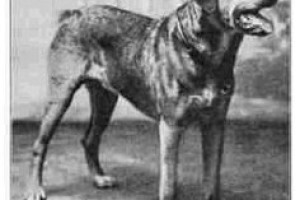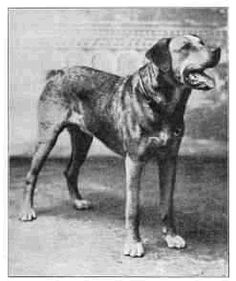Barrenbeisser - Bullenbeisser
This name is (or at least it should be) used to describe a group of dogs, rather than a single breed. Baiting sports were common throughout the world since ancient times, but it was in Western Europe that these breeds were developed specifically for their baiting and fighting prowess. Bullbaiting has roots in an activity considerably less cruel and entertaining, which is that of common livestock control practiced on many farms, even today. Dogs were employed to bite and hold bulls and hogs, while driving them to various destinations, most often to the slaughterhouse. This proved an appealing spectacle for many and grew into a sport. Just like in Roman times, a great number of animals was baited by dogs as far back as the 13th century, but bulls and bears were most readily available in Europe and this influenced the development of specialized "sport" breeds. Various Molossers and hunting dogs of the Alaunt heritage were crossed by the baiting enthusiasts who aimed to create superior canine performers. The ones employed as bear dogs were called Barrenbeissers, while the dogs used for baiting bulls were called Bullenbeissers. Oftentimes these were the same dogs, only listed under different names. These popular German names are quite misleading, seeing how any bulldog or beardog fits the description. When the "sport" of dogfighting became popular, many of these breeds received numerous new misnomers, depending on their respective areas of development.
 Throughout centuries, everyone and anyone was developing "new and improved" baiting and protection breeds, which resulted in a great variety of appearances and temperament traits. Certain bloodlines were quite popular and more or less standardized, while others were constantly being "bettered" through experimentation. Out of all the Bullenbeissers existing in Europe, the most famous strains were the Brabanters and Danzigers. Other than the Scandinavian Brabantse Bullenbijters and quite a few German bloodlines, most of these breeds were poorly or moderately succesful experiments that became extinct in a short period of time. As mentioned earlier, there was an immense variety of types within Bullenbeisser dogs, but three main variants can be used to classify the strains. These are the small, medium and large Bullenbeissers, separated by size and weight, which evolved into the stocky bulldogs, athletic bandogs and large heavy mastiffs. Through crosses with other breeds, the Bullenbeisser bloodline can be traced to quite a few modern dogs.
Throughout centuries, everyone and anyone was developing "new and improved" baiting and protection breeds, which resulted in a great variety of appearances and temperament traits. Certain bloodlines were quite popular and more or less standardized, while others were constantly being "bettered" through experimentation. Out of all the Bullenbeissers existing in Europe, the most famous strains were the Brabanters and Danzigers. Other than the Scandinavian Brabantse Bullenbijters and quite a few German bloodlines, most of these breeds were poorly or moderately succesful experiments that became extinct in a short period of time. As mentioned earlier, there was an immense variety of types within Bullenbeisser dogs, but three main variants can be used to classify the strains. These are the small, medium and large Bullenbeissers, separated by size and weight, which evolved into the stocky bulldogs, athletic bandogs and large heavy mastiffs. Through crosses with other breeds, the Bullenbeisser bloodline can be traced to quite a few modern dogs.
The myth and the ideal of a perfect Bullenbeisser recreation has fueled a great number of revival efforts starting as early as the 1700's, resulting in the great number of Bully breeds found today. And even in present times, new breeds are being developed all over the world following the same legendary ideals and principles.


